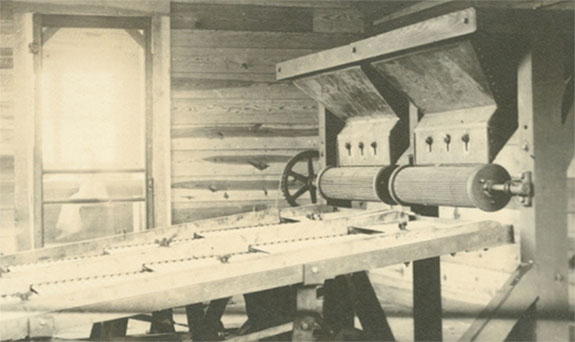100-Year-Old 'Grease Table' Tech Still Helps in Recovery of Small Diamonds
If you mosey on down to the lower level of the Diamond Discovery Centre at Crater of Diamonds State Park in Murfreesboro, AR, you'll see an ingenious piece of diamond-sorting technology that has stood the test of time. It's a replica of a "grease table" that allowed miners to separate small diamonds from dirt, rocks and other minerals.

First invented and used in the late 1890s to support the diamond mining efforts in Kimberley, South Africa, grease tables functioned on the scientific principle that diamonds are naturally hydrophobic, meaning they repel water.
The table is set up as a series of pitched stairs on which a gooey grease is applied. A gentle stream of water enters the table from the top and is collected in a trough below. When fine diamond-bearing material is added to the stream at the top of the stairs, the soil and minerals slide easily over the grease and out the bottom, while even the smallest of diamonds remain relatively dry and get caught in the grease.
At the end of the run, the grease is scraped from the steps and boiled down so the grease turns to oil. At that point, the oil and water separate and the diamonds fall to the bottom of the container, where they can be retrieved.
Before the invention of the grease table, teeny diamonds had to be picked by hand.
Here in the US, grease tables were employed at the diamond processing plants that operated on the current site of Crater of Diamonds State Park, where amateur miners get to keep what they find at the only diamond site in the world that’s open to the general public.
One of the early manufacturers of the tables was the Kimberlite Diamond Mining and Washing Company, which operated from 1912 until 1919, according to an article published on the Arkansas State Parks' website.
Park interpreter Sarah Reap wrote that the company referred to its machine as “unerring,” noting that “even microscopic diamonds are "trapped" and its "power of discrimination is little short of marvellous."
The grease table did have its limitations, however. For the grease to work properly, the temperature in the processing room had to be between 65 and 75 degrees Fahrenheit. If the grease was cold and hard, the diamonds would slide right off. If the grease was too warm, it became too sticky.
According to Reap, modern grease tables use a combination of wax and petroleum jelly.
It's amazing to think that a technology developed more than 100 years ago is still in use today, joining other tried-and-true inventions, such as the light bulb (1879), stapler (1866), bottle opener (1892) and the escalator (1892).
If you'd like to see a grease table in action, check out this video hosted by author and Arkansas diamond mining expert Glenn W. Worthington…
Credit: Image courtesy of Arkansas State Parks.

First invented and used in the late 1890s to support the diamond mining efforts in Kimberley, South Africa, grease tables functioned on the scientific principle that diamonds are naturally hydrophobic, meaning they repel water.
The table is set up as a series of pitched stairs on which a gooey grease is applied. A gentle stream of water enters the table from the top and is collected in a trough below. When fine diamond-bearing material is added to the stream at the top of the stairs, the soil and minerals slide easily over the grease and out the bottom, while even the smallest of diamonds remain relatively dry and get caught in the grease.
At the end of the run, the grease is scraped from the steps and boiled down so the grease turns to oil. At that point, the oil and water separate and the diamonds fall to the bottom of the container, where they can be retrieved.
Before the invention of the grease table, teeny diamonds had to be picked by hand.
Here in the US, grease tables were employed at the diamond processing plants that operated on the current site of Crater of Diamonds State Park, where amateur miners get to keep what they find at the only diamond site in the world that’s open to the general public.
One of the early manufacturers of the tables was the Kimberlite Diamond Mining and Washing Company, which operated from 1912 until 1919, according to an article published on the Arkansas State Parks' website.
Park interpreter Sarah Reap wrote that the company referred to its machine as “unerring,” noting that “even microscopic diamonds are "trapped" and its "power of discrimination is little short of marvellous."
The grease table did have its limitations, however. For the grease to work properly, the temperature in the processing room had to be between 65 and 75 degrees Fahrenheit. If the grease was cold and hard, the diamonds would slide right off. If the grease was too warm, it became too sticky.
According to Reap, modern grease tables use a combination of wax and petroleum jelly.
It's amazing to think that a technology developed more than 100 years ago is still in use today, joining other tried-and-true inventions, such as the light bulb (1879), stapler (1866), bottle opener (1892) and the escalator (1892).
If you'd like to see a grease table in action, check out this video hosted by author and Arkansas diamond mining expert Glenn W. Worthington…
Credit: Image courtesy of Arkansas State Parks.

